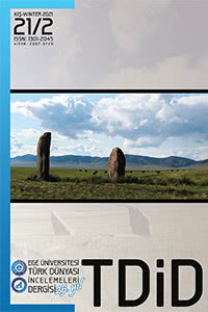Basat’ın Tepegöz’ü Öldürdüğü Destan’ın Yeni Bir Yorumu Üzerine
Bu makale Tepegöz ve eylemlerinin Basat’ın iç gerçekliğinin ve bilinçlenme/ uslanma sürecinin eylemsel karşılığını yansıttığı görüşünü paylaşmak üzere hazırlanmıştır. Bu bağlamda Tepegöz’ü önce tasavvufi anlamdaki nefsin simgesi olarak kabul ediyoruz. Yani Tepegöz de Basat’ın kontrol edilemez nefsi ve ihtirasını simgeler. Dayandığımız gerekçe ise; a) Tepegöz’ün bastırılamayan, dizginlenemeyen nefsin bir sonucu olarak dünyaya gelmiş olması; b) Hikâyede saldırgan, obur, kurnaz ve dokunulmaz olarak karşımıza çıkmasıdır. Bilindiği gibi, nefsin doğasında yırtıcılık/ vahşilik, hayvanlık, şeytanlık ve tanrılık vardır. Nefisteki düşmanlık ve saldırganlığın kaynağı yırtıcılık, oburluğun ve hırsın kaynağı hayvanlık, hilekârlığın ve kurnazlığın kaynağı şeytanlık, büyüklenme ve her şeye tek başına hükmetme arzusunun kaynağı tanrılıktır. Tepegöz nefsin bütün niteliklerini üzerinde taşımaktadır. Mutasavvıflar nefsi köpek, tilki, domuz, yılan ve ejderhaya benzetmişlerdir. Şu hâlde, burada nefis= ejderha= Tepegöz koşutluğu söz konusu olmaktadır. Dolayısıyla, bize göre, Tepegöz nefsin bedenleştirilmiş biçimi ya da görünümüdür. Basat içindeki karşı konmaz nefis ve ihtirası ancak İslam inancıyla yenmeyi başarmış, vahşi hayvani boyutunu terk edip insani boyuta geçmiş, medenileşmiştir. Bu bakış açısının Mundy’nin söz konusu hikâyede tespit ettiği mantıksızlık, tutarsızlık ve kopuklukların, Korkmaz’ın “nedensellik ilkesinin ihmal ve ihlal edildiği yegâne anlatı kusuru” olarak ifade ettiği durumun açıklanmasında daha sağlam bir zemin sağlayacağı kanaatindeyiz
About the New Interpretation of the Epic How Basat Killed Tepegoz
This investigation has been made to share the views about the reflection ofThis investigation has been made to share the views about the reflection ofThis investigation has been made to share the views about the reflection ofTepegoz and its behavior on actual counterpart of Basat’s inner reality and forTepegoz and its behavior on actual counterpart of Basat’s inner reality and forTepegoz and its behavior on actual counterpart of Basat’s inner reality and formation/ settling down duration. In this context we firstly take Tepegoz as themation/ settling down duration. In this context we firstly take Tepegoz as themation/ settling down duration. In this context we firstly take Tepegoz as thesymbol of mystical self. That is, Tepegoz symbolizes Basat’s uncontrollable selfsymbol of mystical self. That is, Tepegoz symbolizes Basat’s uncontrollable selfsymbol of mystical self. That is, Tepegoz symbolizes Basat’s uncontrollable selfand passion. And the justification we base on is; a) Tepegoz was born as a resultand passion. And the justification we base on is; a) Tepegoz was born as a resultand passion. And the justification we base on is; a) Tepegoz was born as a resultof irresistible and unrestrainable passion; b) He appears on the story as an agof irresistible and unrestrainable passion; b) He appears on the story as an agof irresistible and unrestrainable passion; b) He appears on the story as an aggressor, glutton, sly and untouchable creature. As its known the self has in itsgressor, glutton, sly and untouchable creature. As its known the self has in itsgressor, glutton, sly and untouchable creature. As its known the self has in itscharacter rapacity/ brutality, beastliness, satanity and divinity. The source of hoscharacter rapacity/ brutality, beastliness, satanity and divinity. The source of hoscharacter rapacity/ brutality, beastliness, satanity and divinity. The source of hostility and aggression is rapacity, the source of glutton and ambition is beastliness,tility and aggression is rapacity, the source of glutton and ambition is beastliness,tility and aggression is rapacity, the source of glutton and ambition is beastliness,the source of trickery and slyness is satanity, the source of vapourings and domthe source of trickery and slyness is satanity, the source of vapourings and domthe source of trickery and slyness is satanity, the source of vapourings and domination by oneself is divinity in self (soul). Tepegoz carries all the characteristicfeatures of self in itself. Sufis have compared the self with dog, fox, pig, snakeand dragon. In this case, here the self is taken as: self= dragon= Tepegoz parallels. Therefore, we consider as Tepegoz is the inspirited form or reflection of theself. Basat was able to overcome the uncontrolled and irresistible self and passionin himself only with the help of İslam faith, has left his brutal, beastful self andbecome more human and civil. We are convinced that, this point of view will be amore sturdy foundation for the irrationalities, inconsistencies and disconnectionsidentified by Mundy in the above mentioned story and the explanation of thecase which has been expressed by Korkmaz as: ‘the only narrative defect wherethe casualty principle has been neglected and breached’
- ISSN: 1301-2045
- Başlangıç: 1996
- Yayıncı: Ege Üniversitesi Türk Dünyası Araştırmaları Enstitüsü
Sayıdaki Diğer Makaleler
Dede Korkut Kitabı’nda Baba, Oğul ve Baba-Oğul İlişkisi
Dede Korkut Kitabı’nda Tipik Bir İstinsah Hatası Üzerine
1922--1927'de "Kitab--ı Dede Korkut" Hakkında Yapılmış Bir Araştırmanın Yayımlanmamasının Nedenleri
Dede Korkut Kitabında Erginlenme ve Bireyleşme Sürecinde Sınama Motifinin İşlevi
Kuru Göz Tedavisinde Dede Korkut Mucizesi
Prof. Dr. Sait EĞRİLMEZ, Prof. Dr. Metin EKİCİ, Doç. Dr. Oğuz GÖZEN
Uygulamalı Halk Bilimi Açısından Eğitim Sürecinde Dede Korkut
Dede Korkut’ta Yer Alan Atasözlerinde Metaforların İşleyişi
Türklerde At Kurbanı ve Dede Korkut’taki İzleri
Dede Korkut Kitabı'nda Erginlenme ve Bireyleşme Sürecinde Sınama Motifinin İşlevi
